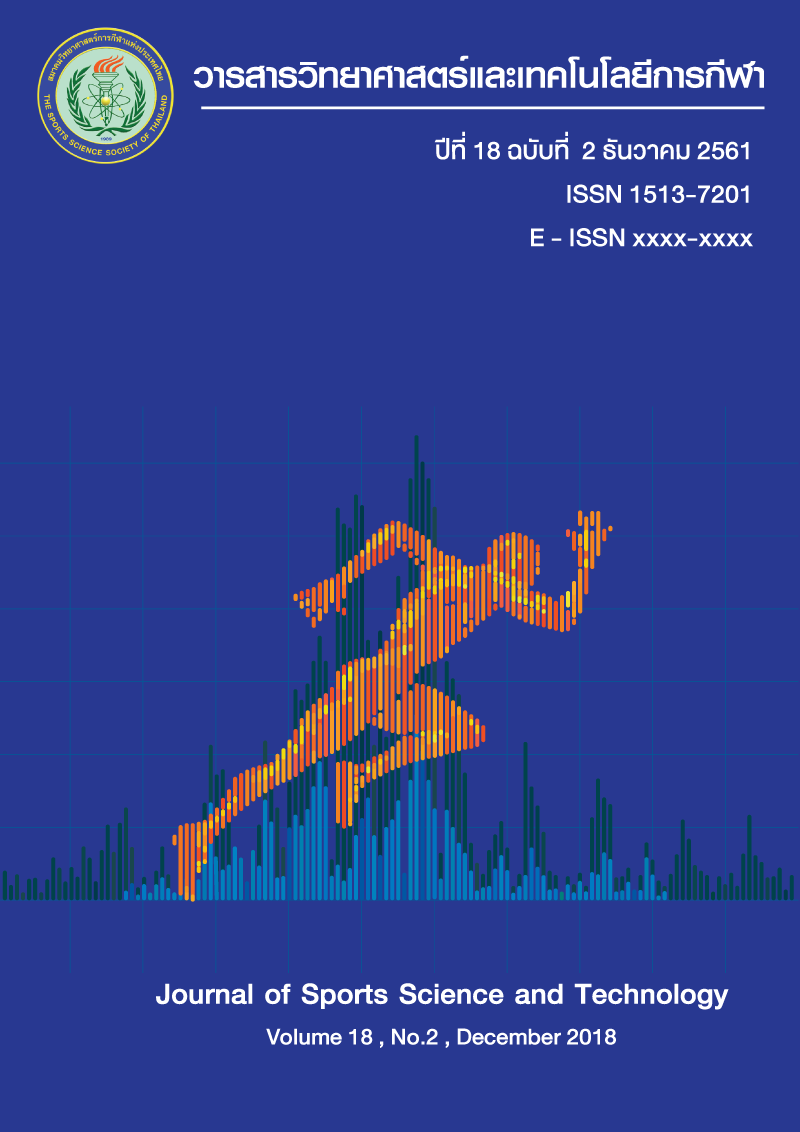LOWER EXTREMITY INJURIES AND ASSOCIATED FACTORS IN MARATHON RUNNERS: A SURVEY STUDY IN BANGKOK MARATHON 2013
Keywords:
Running injury / Marathon runner / Odd ratioAbstract
Musculoskeletal injury is the most common problem in marathon runners, especially lower extremity injury. The injury is influenced by many factors. Lack of study has been reported an association of injury area and relative risk. Therefore, the objective of this study was to study the influencing factors of lower extremity injury including warm-up period, running experience, a frequency of running competition, and type of running surface in full marathon, half-marathon, and mini-marathon runners, Bangkok Marathon 2013. The study surveyed the injury risk of lower extremity from runners who participated in the Bangkok Marathon competition in 2013, Thailand. They were asked about the information relating to competition, practice, running experience, running surface, competitive frequency, and history of injury. The finding of the study exhibited that lower extremity injury was the most common, especially knee and popliteal areas (54.1%). The factor of competitive frequency showed a statistically significant result. Joining ≥ 5 times/year of running competition was 1.417 times more likely to be injured compared with joining 2 times/year (OR 1.027-1.954). This study indicates that higher frequency of competition influences lower extremity injury. Other factors in this study did not significantly influence lower extremity injury including warm-up, running experience, and running surface. Therefore, to prevent injury from marathon running, health professions and runners should aware of the factor of competitive frequency which might relate to physical ability and readiness before joining a competition. (Journal of Sports Science and Technology 2018; 18(2): 73-80) Keyword: Running injury / Marathon runner / Odd ratio *Corresponding author: Attaporn MONGKONPATTARASUK Faculty of Physical Therapy, Mahidol University, Nakhon Pathom, Thailand 73170 E-mail: attaporn.mon@mahidol.ac.th
References
2. Van Gent RN, Siem D, van Middelkoop M, van Os AG, Bierma-Zeinstra SM, Koes BW. Incidence and determinants of lower extremity running injuries in long distance runners: a systematic review. Br J Sports Med, 2007;41:469-80.
3. Satterthwaite P, Norton R, Larmer P, Robinson E. Risk factors for injuries and other health problems sustained in a marathon. Bri J Sports Med, 1999 Feb;33: 22-6.
4. Buist I, Bredeweg SW, Lemmink KA, Van Mechelen W, Diercks RL. Predictors of running-related injuries in novice runners enrolled in systemic training program: a prospective cohort study. Am J Sports Med, 2010;38(a): 273-80.
5. Buist I, Bredeweg SW, Lemmink KA, Van Mechelen W, Diercks RL. Incidence and riskfactors of running-related injuries during preparation for a 4-mile recreational running event. Br J Sports Med, 2010;44(b): 598-604.
6. Faber R, Davis IM, Williams DS. Gender differences in lower extremity mechanics during running. Clin Biomech, 2003;18:350-7.
7. Wei-Ling Chang, Yi-Fen Shih, Wen-Yin Chen. Running injuries and associated factors in participants of ING Taipei Marathon. Phys Ther Sport, 2012 Aug; 13(3): 170-4.
8. Upiriyasakul R, Bovonsunthonchai S, Sakunkaruna Y, Sakunkaruna S, Thong-on S, Laisirirungrai D. Incidence of Injuries in Marathon Runners; Bangkok Marathon. J Sport Sci Tech, 2015;15(1): 171-8.
9. McGowan CJ, Pyne DB, Thompson KG, Rattray B. Warm-Up Strategies for Sport and Exercise: Mechanisms and Applications. Sports Med, 2015 nov;45(11):1523-46
10. Curry BS, Chengkalath D, Crouch GJ, Romance M, Manns PJ. Acute Effects of Dynamic Stretching, Static Stretching, and Light Aerobic Activity on Muscular Performance in Women. J Strength Cond Res. 2009Sep;23(6):1811-9.
11. Hotta T, Nishiguchi S, Fukutani N, Tashiro Y, Adachi D, Morino S, Aoyama T. The association between plantar heel pain and running surfaces in competitive long-distance male runners J Sports Med Phys Fit, 2016 Sep;56(9):1021-5.






